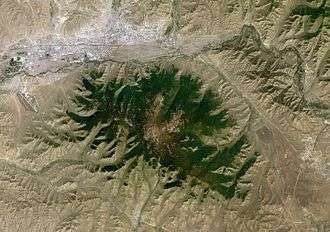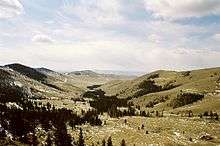Bogd Khan Mountain
| Bogd Khan Mountain | |
|---|---|
 Bogd Khan Mountain Location on Mongolia | |
| Highest point | |
| Elevation | 2,261 m (7,418 ft) |
| Coordinates | 47°48′14″N 106°59′11″E / 47.80389°N 106.98639°ECoordinates: 47°48′14″N 106°59′11″E / 47.80389°N 106.98639°E |
| Geography | |
| Location | Mongolia |
| Parent range | Khentii Mountains |


The Bogd Khan Mountain (Mongolian: Богд хан уул, lit. "Saint Khan Mountain") is a mountain in Mongolia that overlooks the nation's capital, Ulaanbaatar, from a height of 3000 feet (914 m) above and to the south of the city.[1]
World Heritage Status
The Bogd Khan Mountain, along with Mongolia's other sacred mountains Burkhan Khaldun and Otgontenger, was added to the UNESCO World Heritage Tentative List on August 6, 1996 in the Cultural category. World Heritage sites are those that exhibit universal natural or cultural significance, or both. In 1783 the local Mongolian government of the Qing Dynasty declared the Bogd Khan a protected site, for its beauty. This makes it the oldest legally protected natural area in the world. It is about 7440 feet tall.
Imperial recognition in 1778
In 1778 the Mongolian governor (minister) of Khuree (Urga, present day Ulan-Bator) Sanzaidorj sent a letter to the Qianlong Emperor requesting approval of annual ceremonies dedicated to Mount Bogd Khan Uul. The Mongolian letter and the reply from Beijing in Mongolian is kept in the Central State Archives of Mongolia.
The text of governor Sanzaidorj's letter reads:
Your servant San and us we hereby raise and pronounce this earnestly. Reason for begging Royal Decree: Upon inspection, in the south of Khuree there is a certain Khan Uul. This mountain is very big. Whenever the four Khanates (Aimag) of the Khalkha gather in Assembly this mountain is the place they point out for gathering. And the multitudes of lamas and disciples of the Jebtsundamba Khutugtu all reside here. The word handed down among the locals here says: This mountain is called Khan Uul because Genghis Khan had lived here originally. Indeed the many princes, dukes, banner governors, saints and disciples of the Khalkha all regard this mountain as marvelous and the former old Khutugtu (Zanabazar) himself worshipped it. Until now the many locals here never hunt the animals of the mountain as if they were entitled to hunt them, nor do they move the trees as if they had the right to do so. Your servant Sanzaidorj and the lamas have annually worshipped the mountain, as have each of the princes, dukes and banner governors who come to participate in the Assemblies. As your servants see it, if the Lord sends incense and all necessary silks from the relevant subject ministry and ensures annual officially funded worship ceremonies, it seems that would greatly benefit the many people here. In addition, the many princes, dukes, banner governors and lamas have discussed this and agree in totality. Therefore we your servants joyously say to each other now that it is fitting for us to await your Divine Lordship’s unbending charity and blessing. Upon inspection, Mosuur Pass, Mount Geden and Mount Altai are all currently being worshipped by official funds. Since all the saints and disciples of the four Khanates of the Khalkha are earnest in saying that this Khan Uul is very marvelous, please deign to allow annual officially funded worship ceremonies in the same way as is done for Mosuur Pass. If dispatches are sent as has been begged for in this request for Royal Decree, every year during the two seasons of spring and autumn incense and all necessary silks can be sent to your servants from the subject ministry while here cows, sheep and the like can be provided. Then your servants will receive them and hold ceremonies twice annually. Pronounced earnestly for this reason, we beg Royal Decree.17th day of the 9th month of the 43rd year (1778) of Tengeriig Tetgesen (Qianlong reign period)[2]
To this the Board for Administration of Outlying Regions in Beijing replied in Mongolian:
Note of the Gadagadu Muji-yi Zasahu Jurgan (Board for the Administration of Outlying Regions). Sent to the Ministers residing in Khuree. Copy obtained from the Interior Ministry. A Royal Decree was issued on the 25th day of the 9th month of the 43rd year of Tengeriig Tetgesen saying: From the administration of Sanzaidorj has come the pronouncement that in the south of Khuree there is a certain Khan Uul. All the princes, dukes, banner governors, saints and disciples of the Khalkha are earnest in saying that this mountain is marvelous. Upon review, it has been raised, pronounced and begged that incense and all necessary silks be sent from the interior in order that worship ceremonies be held in the same way as is legally done for Mosuur Pass. Without delay, let it be ordered to the subject Department that every year in the two seasons of spring and autumn, in accordance with the request raised by Sanzaidorj, incense and all necessary silks are to be sent to Sanzaidorj and his counterparts while other necessary materials are to be provided and prepared there at that place. Then bring the princes, dukes and banner governors and let worship ceremonies be held. Earnestly obeying this Decree a copy has been sent to this Board. Therefore we have sent it to the Ceremony Ministry and had them examine and implement the internal contents of the Decree. We have also determined that it be sent and made known to the Household Department and to the Ministers residing in Khuree. Sent for this reason.29th day of the 9th month of the 43rd year (1778) of Tengeriig Tetgesen (Qianlong reign period)[2]
References
- ↑ Mongolia Sacred Mountains: Bogd Khan, Burkhan Khaldun, Otgon Tenger - UNESCO World Heritage Centre
- 1 2 Documents on worshipping Khan Uul. Mongolian Governmental Implementing Agency. General Archive Authority.
External links
| Wikimedia Commons has media related to Bogd Khan Uul. |